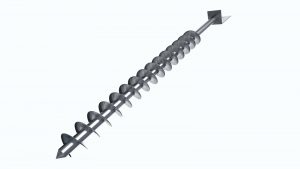Design and Stretching of Industrial Screws
The design and stretching of industrial screws are essential for power transmission, material handling, motion and speed control, pressure and temperature regulation, efficiency enhancement, and performance improvement in a number of industries, comprising automotive, aerospace, electronics, water and wastewater management, medical, and others. These screws have gained significant attention because of their ability to transmit power and signals within a closed tube of small diameter, requiring minimal installation space and being appropriate for harsh conditions and adverse weather.
Efficiency of Screw Conveyors in the Feed Industry for Livestock and Poultry
Screws play a crucial role in the animal feed industry as one of the main devices for material transportation. This device, capable of moving at different angles, efficiently transfers feed from one point to another.
Using screws, various types of feed, such as rations and soybeans, are transferred dry or semi-wet towards animal husbandry and poultry equipment. As well, these screws are used to transport the produced feed from animal feed factories to the distribution points. We recommend making your favored purchase at extremely low prices with free shipping, and you can also pick up your order on the same day from the store.
Moreover, using screws in the animal feed industry decreases transportation costs and increases speed and accuracy in feed transfer. It ensures that different types of feed are delivered uniformly and consistently without affecting their quality.
Overall, using screws in the animal feed industry improves performance, lowers transportation costs, and greatly boosts the industry’s efficiency.
Designing an Industrial Screw
The design of an industrial screw involves the following steps:
Determining the Type of Screw: First, you must fix the type of screw according to the application and working conditions. For instance, steel screws are proper for heavier applications and higher temperatures, while plastic screws are better for lighter applications and lower temperatures.
Selecting Diameter and Thickness: The diameter and thickness of the screw should be selected based on pressure, temperature, material, and covering components.
Screw Length: The screw should be long enough to be easily installed and moved.
Determining Manufacturing Details: This includes details like the type of coating, connection methods, stabilization techniques, and packaging methods.
Designing the Blueprint: After determining the manufacturing details, a blueprint of the screw is designed, including dimensions, manufacturing and installation details, and necessary instructions for screw production.
Manufacturing: After the blueprint is designed, the screw is produced by screw manufacturing factories.
Inspection and Testing: After production, the screw must be inspected and tested to ensure it meets the required specifications.
Screw Production Method
Manufacturing a screw might seem simple owing to its basic shape, but it is not. Creating a highly precise and tolerance-free screw requires accurate design calculations and high sensitivity in manufacturing.
Steps in Screw Manufacturing:
Material Quality Control: The initial steps, like purchasing pipes, sheets, etc., must meet defined quality standards and require physical inspections. For instance, the pipe should be checked for warping, sinusoidal shapes, or tapering.
Pipe Sizing: The pipe must be sized precisely to fit the installation location, as any divergence in length can modify the slope and the shafts at both ends of the device.
Blade Dimensions: Blade dimensions are crucial in determining the amount of material transferred. Considering the pipe diameter, external screw diameter, and desired pitch, the blades should be calculated, cut, and formed.
In production, initial calculations are made for the primary size of the screw blades, and after forming, the required pitch is achieved by means of numerous methods:
Mathematical or Theoretical Methods
Software Usage: In this method, various software like SolidWorks, PNS4, or other mechanical design software is used to obtain dimensions before forming.
Cutting:
Cutting must be done using CNC cutting machines to optimize the use of raw sheets.
Sheet Forming
One of the most critical and complex parts of screw pump manufacturing is forming the blades. For different internal and external diameters and pitches, the forming equipment must be specifically designed and calculated to ensure uniform and consistent spacing without distortion. To achieve this goal, a machine for blade manufacturing has been exclusively designed and built by Noormandi Machinery.
Installing the Sheet on the Pipe:
The formed sheets are sequentially installed on the pipe at equal distances.
Welding:
Welding of the sheets is carried out according to welding instructions, ensuring that the welds are uniform and free of holes or cracks.
Noormandi Machinery Company has expanded its activities by recognizing the current needs of the animal feed industry in our beloved country, adhering to proper engineering principles, and utilizing international standards. The company designs, installs, operates, and sells up-to-date machinery for producing animal and poultry feed.
The company’s management has successfully introduced modern feed machinery technologies, including production lines for animal feed factories, to the country’s livestock and poultry industry. The company has always prioritized customer satisfaction, setting its policies to respect and protect customer rights. Consequently, customers can rely on Noormandi Manufacturing products and services for many years, with the hope that, with the grace of God and the tireless efforts of the company’s staff, significant strides will be made towards the growth and prosperity of our beloved Iranian livestock and poultry industry.




